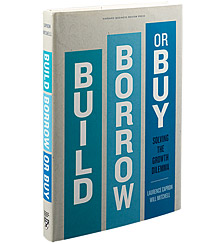Sourcing Growth
A review of Build, Borrow, or Buy, by Laurence Capron and Will Mitchell.
Build, Borrow, or Buy: Solving the Growth Dilemma
by Laurence Capron and Will Mitchell
Harvard Business Review Press, 2012
In the 13 quarters after January 2009, economic growth in the United States averaged a mere 1.4 percent. That’s the longest consecutive run of quarterly growth below 4 percent in more than 60 years. In such an environment, companies must field the right resources—the know-how, technology, processes, and people—in the right way if they are to have any chance of generating consistent, healthy levels of growth. That’s why Build, Borrow, or Buy: Solving the Growth Dilemma, by professors Laurence Capron, of INSEAD, and Will Mitchell, of Duke University’s Fuqua School of Business, is such a timely book.
The book is a highly structured examination of the three fundamental modes—or “pathways”—for obtaining the resources needed to grow. They are developing the needed resources internally, or “building” them; contracting or partnering to obtain resources, or “borrowing” them; and acquiring, or “buying” them. According to the authors, companies should be adept at all three. In a study of the telecom industry, they found that “firms using multiple modes to obtain new resources were 46 percent more likely to survive over a five-year period than those using only alliances, 26 percent more likely than those using only M&A, and 12 percent more likely than those using only internal development.”
What is most striking about Build, Borrow, or Buy is its finding that most companies use only one or two of the pathways. Perhaps that is because it is hard to use all three effectively and to smoothly switch among them. The authors offer a litany of obstacles, including internal conflicts of interest, organizational biases, entrenched habits, and past mistakes. Given these barriers to obtaining the right resources in the right way for any particular strategy, it’s surprising that any company can sustain growth beyond its initial market success. The magnitude of this challenge may also explain why there has been almost a complete turnover of the S&P 500 in the last few decades.
Obtaining the requisite resources to support profitable growth is a major leadership challenge that begins with choosing the right pathway in a particular situation. The authors suggest that executives first consider building resources, then think about borrowing them, and settle on buying them only as a last resort. This order of preference is based on their premise that the complexity increases and the success rate falls as you go from build to borrow to buy.
Capron and Mitchell provide a simple decision tree for navigating the build, borrow, or buy choice. It requires answering four questions in this sequence:
1. Do you have internal resources that “are similar to those you need to develop and superior to those of competitors”? If so, build.
2. Can you easily trade for the necessary resources? If so, borrow via contract.
3. Do you need to collaborate closely with the resource supplier? If so, borrow via alliance.
4. Can you successfully acquire and integrate the resource supplier? If so, buy.
Although these questions are straightforward, the authors make it clear that answering them in an honest, open-eyed way is not so easy. The book offers many insights, tips, and examples to help practitioners in this endeavor.
A key message of Build, Borrow, or Buy is that whatever pathway a leader chooses in a particular situation, it will be a means to the same end: obtaining the resources needed to pull off a strategy. This distinction between how you obtain the resources to execute a strategy and the strategy itself is useful in that it helps companies avoid the trap of reducing their strategy to sourcing decisions. When that happens, borrowing and buying growth can become a dangerous—and ultimately unsustainable—crutch for companies that have found it difficut to grow organically.
The book actually addresses only part of the “growth dilemma” referenced in its subtitle: It explains how to identify the best modes of obtaining the resources needed for growth, but it presumes that the reader knows how to create the right strategy for growth and how to identify the resources needed to execute it. Nevertheless, Capron and Mitchell present a cogent framework for answering the mode question, along with many rich examples that enliven what might otherwise be a pretty heavy slog.
No strategy is complete until the mode question is answered, and many strategies fail because no one thought to ask it. Moreover, confident decisions about what strategy to adopt and what capabilities to develop are highly dependent on knowing how to obtain the required resources. For these reasons, reading Build, Borrow, or Buy could help you enhance your company’s strategy as well as its execution. ![]()
Author profile:
- Ken Favaro is a senior partner with Booz & Company based in New York, where he leads the firm’s work in enterprise strategy and finance. He writes the “Capable Strategist” column for strategy+business.


